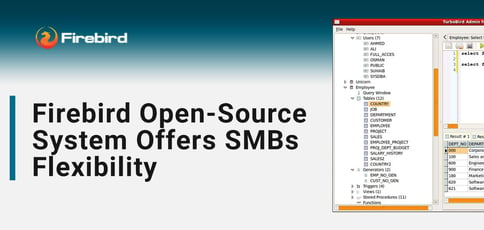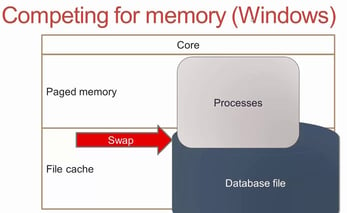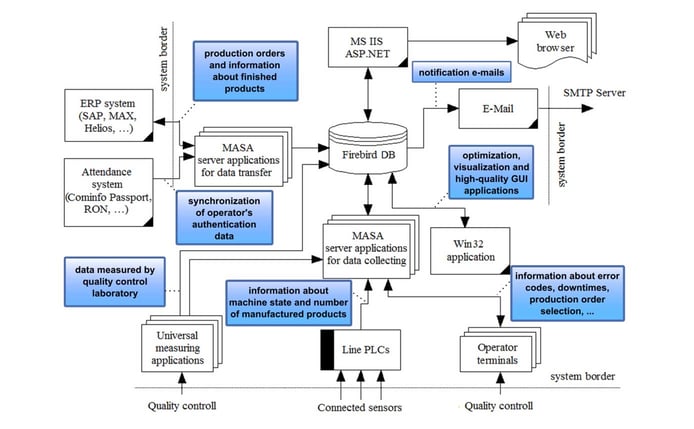
TL; DR: Firebird is an open-source relational database management system that offers modern features for in-house app development. Its solutions run on a wide range of operating systems, including Mac, Linux, and Windows, making them accessible to SMBs and enterprises. It offers high degrees of concurrency and performance, and has been used to innovate in the production systems industry since 1981. Its current user base crosses multiple verticals, sector-specific applications, and business use cases.
Database management systems (DMSs) are the software engines of countless enterprise applications, ranging from finance and payroll to customer support and healthcare. The architecture on which those databases run can make or break an application, whether it is through on-premises infrastructure or hosted on cloud platforms.
The database market has long been dominated by proprietary commercial solutions from corporate software giants, including IBM, Microsoft, Oracle, and SAP. During the 2010s, however, open-source alternatives were proven worthy of managing mission-critical enterprise workloads. In recent years, open-source relational database management systems (RDMSs) have seen steady adoption across verticals.

According to Gartner, open-source RDMSs are increasingly making their way into corporate IT environments. The analysis shows that by the end of 2022, at least 70% of businesses will develop in-house applications on an open-source DMS or a cloud-hosted open-source-based Database Platform-as-a-Service.
Firebird is a well-established open-source SQL RDMS that runs on Linux, Microsoft Windows, Mac OS X, Android, and a variety of Unix environments. The software, first released in 2002, had its origins in Borland’s open-source edition of the InterBase RDMS, although the source code has changed substantially over the years.
The nonprofit Firebird Foundation supports and administers the open-source solution, while a dedicated community helps keep it updated. While Firebird is free to download and install, most user organizations donate to the Foundation to finance its work and ensure future software iterations.
“The attributes of Firebird I’d commend most are its flexibility and scalability,” said Jason Wharton, President at Firebird Foundation. “You will find it running as part of a very wide range of enterprise applications, from CRM to HR. In fact, you’ll find Firebird just about anywhere doing just about anything.”
Scalability, Stability, and Flexible Approach to Locking
According to its many testimonial-style case studies, Firebird provides comparable quality and performance to commercial proprietary databases. Some users laud its scalability and stability, while others enjoy its ease of configuration.
“For many users, it is Firebird’s underlying multigenerational architecture that wins hearts and minds,” said Jason.
In databases, multigenerational architecture — also known as multiversion concurrency control — means multiple versions of records are kept in the database as long as at least one transaction needs them.

“With most traditionally architected databases, you have page locking. The system will lock an entire page if one record is being accessed by a given application,” Jason told us. “Page locking has been somewhat difficult and rather annoying for database admins, but Firebird has row-level locking. That means only the row accessed by an application will be locked. All other rows that belong to the same page can be used by other applications.”
Each active transaction retains consistent access to the database, and the records it needs are not deleted or changed — even if other transactions modify or delete them. That is part of Firebird’s overarching database philosophy: Readers don’t block writers, and writers don’t block readers.
Firebird’s multigenerational architecture also ensures that operations can occur simultaneously through online transaction processing (OLTP) and online analytical processing (OLAP). That also eliminates the need for the type of locking protocols found in most legacy database systems.
“With Firebird, users can have the two types of transactional activity, OLTP and OLAP, that in normal operational circumstances would be just about impossible on any other database,” Jason told us.
Architecture Allows Reports to Run Without Workflow Interruptions
According to Jason, multigenerational architecture also benefits businesses by providing access to some handy operational features.
“Take a situation where database admins have got a long-running snapshot report that they want to output. But then, they have their active sales teams who are, at the same time, making changes in the database,” said Jason.
Typically, the administrators would need to maintain an updated read-only version of that database to run their report. That means unnecessary redundancy that may fragment business processes.

“It would be completely unthinkable to run long-running reports against a conventional transactionally active database. But with Firebird, it’s not a problem,” Jason said.
Firebird’s development and support of hybrid OLTP and OLAP applications make its database capable of serving simultaneously as an analytical and operational data store for businesses of all sizes. That dynamic is made possible because readers do not block writers when accessing the same data under most conditions.
Jason also pointed out that a complete Firebird system installation takes just two to three minutes.
“Enterprises can have a fully functional Firebird database up and running in a very short period of time,” Jason said. “Therefore, with Firebird installs, time-to-value is pretty much immediate.”
Support and Development Funded by Community Donations
For open-source solutions to find success, they need sustained support from a dedicated user community — and that support should be coordinated and collaborative. Two volunteer support organizations are primarily behind Firebird: Firebird Project, which develops the software and oversees its day-to-day operation, and the Firebird Foundation, the nonprofit membership organization that administers the continued development of Firebird and its related products.
“Firebird has a strong, long-standing following among the developer and user communities,” Jason said. “The Firebird Foundation is an organization that comprises, and is supported by, these individuals and companies of various sizes and pronounced diversity. They all work together as parts of an organization that aims to ensure the continued development of the Firebird RDMS and related products.”
In addition, the dues paid by Foundation members play a critical role in funding future Firebird development.
“As an organization, we are serious about maintaining a financial backbone for the ongoing development of Firebird,” Jason said. “And I might add that Foundation members regard it as a privilege to pay subscription fees for memberships.”
Membership dues are payable annually in advance. Voting members pay a full subscription of $300 per year — which members can also pay monthly if they have an Australian bank account or PayPal account. Firebird users who want to show their support as Associate members pay an annual subscription of $50. Details on how to get involved or sign up for a membership are available on Firebird Foundation’s Membership website.
“New members are always welcome, naturally,” said Jason. “In fact, the Foundation’s capacity to facilitate Firebird’s progress depends on a growing membership, and that is happening now.”


